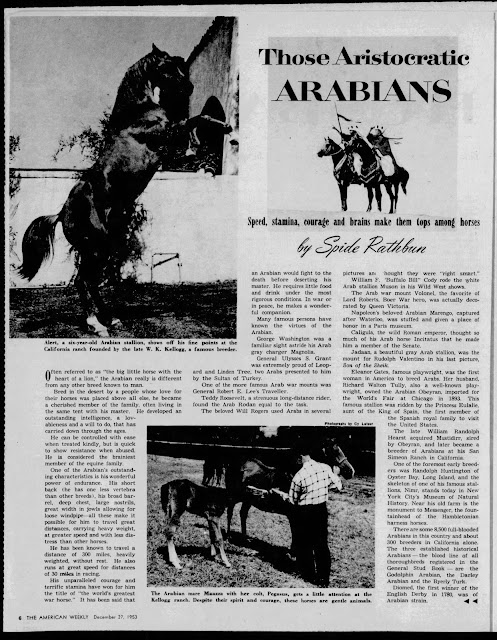 |
| "General Roberts on Vonolel, [circa] 1881." Photograph by John Burke, India. National Army Museum, London https://collection.nam.ac.uk/detail.php?acc=1955-04-46-5 |
[Updated 24 October 2023 with additional information and photographs!]
One of the hazards of equine history research is that you always find "sidebar" stories that are so interesting you have to stop what you're doing and pursue the sidebar, also known as "going down a rabbit hole (or trail)."
Sometimes the only way to get out of the rabbit hole is to write about it, close its file, and go back to your original topic. So I'm going to tell you about the Arabian called Vonolel. I found him at the bottom of a recent rabbit hole.
This time, my original research subject (as it so often is) was W. K. Kellogg, the Battle Creek, Michigan millionaire cereal manufacturer whose Arabian horse ranch in Pomona, California had such an impact on the breed in the twentieth century.
Earl Henry "Spide" Rathbun (1886 -1961) was one of the many people connected with the Kellogg Ranch who helped promote the Arabian breed. A Battle Creek native, Rathbun did publicity for W. K. Kellogg, as did the Kellogg company's advertising agency, N. W. Ayer and Sons.
In later years, Rathbun became known as an expert in all things Arabian horse. His business was called Calarabian (as opposed to Calarabia, the Arabian horse ranch owned by E. E. Hurlbutt). Rathbun's letterhead was embellished with the famous "Three Graces" photograph of the Kellogg Arabians "Latif" (registered as Deyrak), Arak, and Fasal. "Research on the Arabian Horse in California," the stationery proclaimed.
 |
| Part of the first page of a 1949 letter from Spide Rathbun to W. K. Kellogg, in the collection at the W. K. Kellogg Arabian Horse Library. |
Rathbun's article on Arabians was published in the San Francisco Examiner on December 27, 1953, called "Those Aristocratic Arabians."
 |
So naturally I had to stop what I was working on and look up Field Marshal Frederick Sleigh Roberts (1832-1914) and his "beautifully diminutive" Arabian stallion. I reached out to the National Army Museum in London, and they corrected my original spelling of the horse's name: it was actually Vonolel.
Surely, I thought, if Queen Victoria had decorated Vonolel, the newspapers of the day would have written about him. And they did.
Vonolel appears to have been foaled in 1872, perhaps in India. This illustration of Roberts and Vonolel, "his little grey Arab," appeared in the London Daily Telegraph, 21 December 1899.
 |
A search of the Internet led me to a copy of the July 1900 issue of Cassell's Magazine for sale online. And there they were on the cover, the "Best of Brilliant Soldiers: Field Marshal LORD ROBERTS on his celebrated Arab charger, 'Volonel.'"
 |
 |
| Source: National Army Museum website. (Out of Copyright.) NAM. 1983-07-9-1 |
The online description reads:
Roberts purchased his Arab charger 'Vonolel' while he was still a major soon after the Lushai Expedition in India (1871-1872), during which he defeated the son of a locally renowned chief after whom the horse was named.
Although little bigger than a pony, 'Vonolel' was his master's only reliable horse during the 2nd Afghan War (1878-1880) and carried Roberts on the celebrated march from Kabul to Kandahar. Thereafter he became a familiar sight at ceremonial parades and camps of exercise throughout India. He accompanied Roberts to Ireland where the latter served as Commander-in-Chief from 1895 to 1899.
 |
| Source:National Army Museum. Out of copyright. https://collection.nam.ac.uk/detail.php?acc=1955-04-46-4 |
 |
| By © MSeses / Wikimedia Commons, CC BY-SA 4.0, https://commons.wikimedia.org/w/index.php?curid=48101680 |








.jpg)


